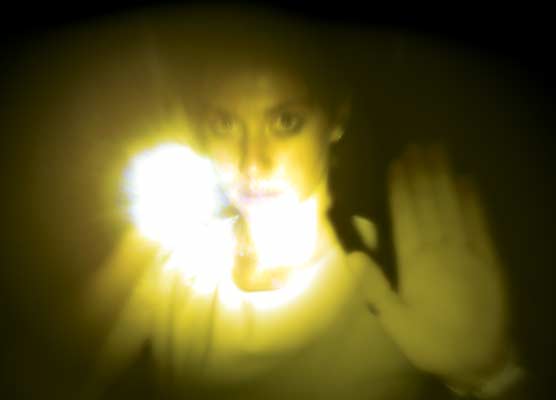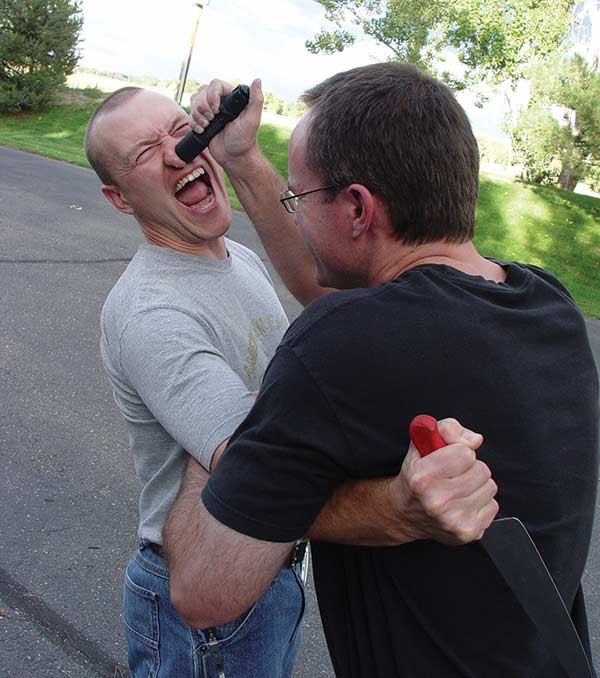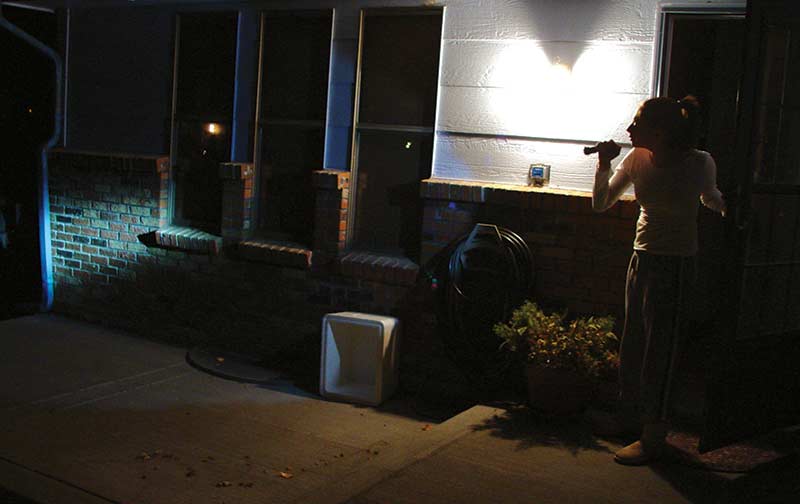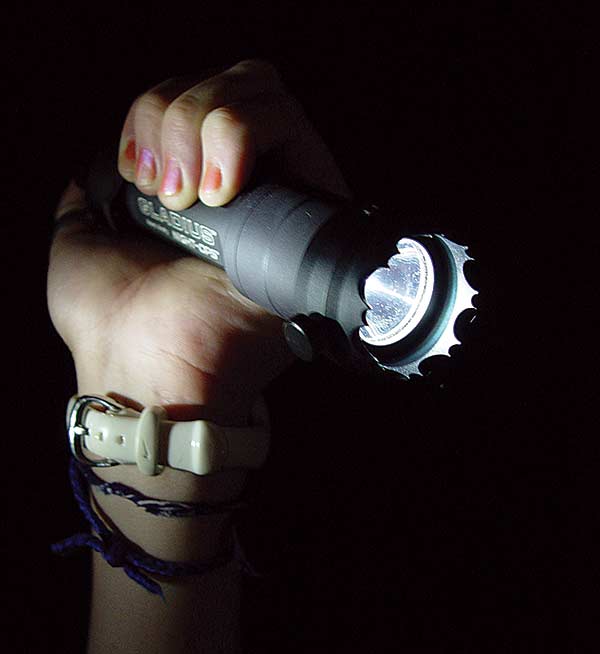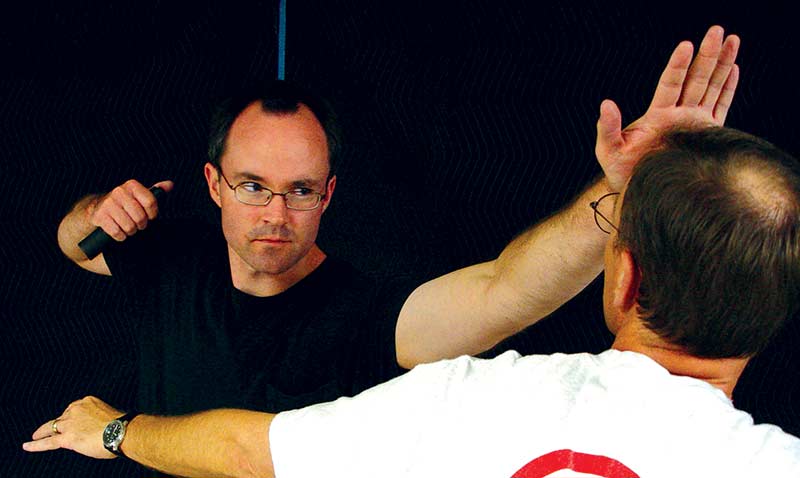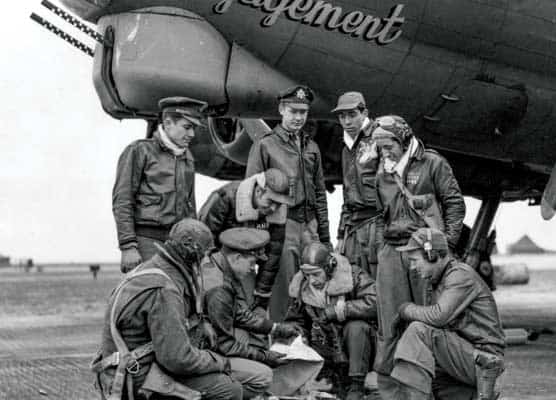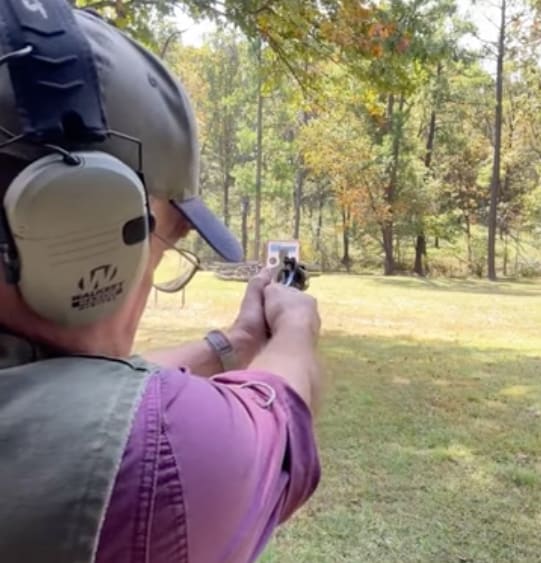Have You Seen The Light?
Flashlight Tactics For Personal Defense
Mention flashlight and personal defense in the same sentence and gun people automatically think of lowlight shooting and a plethora of ways of trying to stick your hands together while operating both a light and a pistol. Conversely, non-gun people (or at least gun people who are forward thinking enough to train in non-gun skills), typically think of the flashlight as a Kubotan or striking weapon that also, coincidentally, happens to emit light.
Although both of these thought processes are valid, the latter approach — the use of the flashlight as a standalone personal-defense tool — often doesn’t get much attention. When it does, the focus of attention often fails to address the light’s full defensive potential. This article is designed to allow you to “see the light” when it comes to applying flashlights in the personal protection role.
Tactical Flashlight Attributes
All too often the word “tactical” means painting a product black and doubling its price. However, the qualifications of a true tactical
flashlight are actually pretty clear. To really function well in all possible personal-defense applications, it needs to have the following attributes:
• At least a 60 lumen output with a pre-focused beam
• An impact-resistant bulb — either an LED or a shock-isolated incandescent bulb
• Solid, high-quality construction supporting its use as an impact weapon
• Ergonomics allowing a solid grip and effective management of impact shock when used as a striking tool
• A large enough size to grasp firmly with at least a half-inch of the light protruding from each side of your fist
• A small enough size to be conveniently carried
• A pocket clip or carrier allowing an immediate access and draw
• A tail-mounted switch that allows momentary actuation of the light
If your light has all these features, it qualifies as a lighting tool and a potent weapon — exactly what you need on the street.
Awareness
Now that we have a proper tool, let’s look at its first level of tactical application — awareness. Awareness is a term thrown around a lot in self-protection training, but it takes on special meaning when you add a lighting tool to the equation. Awareness requires the ability to see in darkness, or at least diminished lighting conditions where many attacks occur.
Imagine that you’re out late at a restaurant and it’s time to go home. To do so, you need to leave the safety of a crowded public place and navigate through an area full of shadows and potential hiding places to get to your parked car. Under normal circumstances, a cretin lurking in a shadow would have the element of surprise on his side. However, by using the light to eliminate those shadows from a safe distance, you not only identify potential threats before you get close to them, you also let the world know you are alert and actively aware of your surroundings. That “hardtarget” appearance is a powerful deterrent in and of itself.
As you near your car, you also use the light to illuminate the interiors of nearby vehicles as well as the areas under your car and others nearby. Finally, with your keys already in your left hand (assuming you’re right handed) you use the light to illuminate the inside of your car, including the back seat. With your head up and still scanning, you unlock only the driver’s side door (preferably with a remote key), get inside, and lock the door again, keeping your flashlight on the seat next to you just in case you need it.
Almost A Projectile
Personal tactical weapons fall into two basic categories: contact weapons and projectile weapons. In simple terms, you either hold it in your hand and get close enough to whack someone with it or launch something from a distance so you don’t have to get too close. Although the tactical f lashlight isn’t a projectile weapon per se, if it is bright enough, it does have the power to temporarily blind and disorient an attacker from a distance by simply shining the light directly into his eyes.
If we again assume our late-night, walk-back-to-your-car scenario, let’s say one of those shadows happens to contain someone with “less-than-honorable” intentions. If destroying his concealment wasn’t enough to spoil his plans, when he approaches you and your verbal command “stay back!” isn’t enough to deter him, your next step is to hit him square in the eyes with the hot spot of your light.
According to my friend Vaughn Baker, President of Strategos International low-light training programs — it takes about 25 minutes for the human eye to become fully dark adapted. When it is, it’s 100,000 times more sensitive to light than during normal lighting conditions. That means the beam of your 85-lumen tac light will not only hit like a hammer, it will leave your unwelcome companion disoriented and temporarily blinded long enough for you to make a safe escape. If he does try to follow, make sure your escape route includes plenty of obstacles and uneven terrain he won’t be able to negotiate effectively in a semi-blind state.
A Force Multiplier
A force multiplier is any tactical advantage increases the effectiveness of another weapon or tactic. Simply put, it makes a good thing better. Let’s say you’re back in the same scenario and en route to your car. You’re feeling confident because you know that in addition to the power of light, you also happen to have several years of martial arts or self-defense training on your side.
Once again, illuminating your attacker and setting boundaries with verbal commands isn’t enough to make him cease and desist. He continues to advance toward you with his right hand concealed behind his thigh and mouth spewing threats and obscenities. It’s clear he’s up to no good and there is no simple escape.
Keeping your light off as he approaches, you wait until the distance is right and hit him in the eyes with the hot spot of the beam. Whether you destroy his night vision or he averts his eyes to avoid the light, it doesn’t matter; he doesn’t get to see life for the next couple of seconds. He does get to feel it, though, as you take advantage of his blindness to drive a full-power kick into his groin, and then stomp on his ankle to turn it into a maraca.
Escaping is easier now and you’re sure he can’t follow you, but you remain alert because you know the possibility of multiple attackers is high.
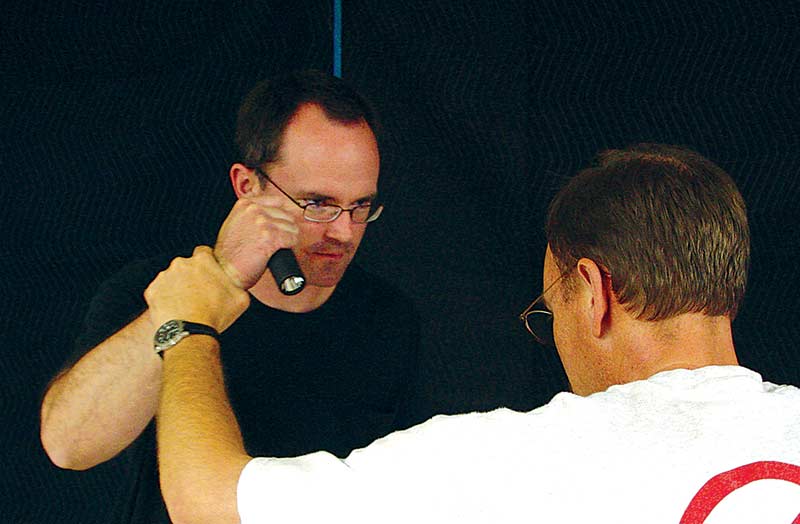
The basic striking sequence with the flashlight is a repetitive left-right pattern
called “cycling.” A multi-purpose sequence, here it is shown as a counter against
a grab against the light hand. The left hand strikes high on the head (away from the teeth)
as the right hand cycles downward to break the grab. As it comes up, the light is activated
to blind the attacker before hammering him with the bezel.
Swing Away!
For whatever reason, all the other options described above either didn’t work or things happened too quickly. Before you know it, he’s closed on you and the right hand behind his thigh whips quickly toward your head. It’s time to test the shock resistance of your light.
Both your hands drive forward simultaneously to execute a “shoulder stop.” Your left hand stops his lower arm as you drive your right fist — light and all — into the front of his shoulder. His arm stops like it hit a wall and you prepare for your turn.
You drive your left palm high into his head, covering his eyes (while staying away from those disease carrying teeth) and gauging distance. Your right hand coils back and, just as your left hand slides away, brings the bezel of the light smashing down onto the bridge of his nose. Instantly the left hand is back in action, this time indexing on his right shoulder so the right hand knows exactly where in space his collarbone is — well, was.
He throws up his other arm to try to fend you off. It becomes your next target of opportunity as you smack it, skill sweep it out of the way with your left hand, and look for something else to hit. This basic technique of striking with the flashlight — borrowed from my friend Kelly McCann’s combatives curriculum — is called “cycling” for a reason.
After several rounds of left-right search and destroy, you’ve got him prepped. The best time to leave is when you’re sure he can’t follow, so you use the fact that he’s “preoccupied” with his rapidly disintegrating upper body to pick an ankle to break with a lowline kick.
Once he’s down, again use the light to help you scan for other possible threats and to navigate to safety.
Flashlight Tactics
The above scenario is just one representative example of the use of the flashlight as an impact weapon. Because of its size and shape, it can be easily substituted for a yawara, Kubotan, or Filipino pocket stick and works extremely well with the traditional techniques for those weapons. However, it works better when you remember it’s a flashlight and that powerful flashlights can be used to momentarily blind people.
The basic flashlight curriculum I teach is derived from the reverse-grip knife tactics of the Filipino martial arts. In reverse (or ice-pick) grip, the blade extends from the little-finger side of the hand and the end of the handle is “capped” with the thumb. Cutting is typically done in upward or inward strokes and thrusting is either a downward, inward, or backhand “hammerfist” motion.
Replace the knife with a flashlight and the capped butt puts the thumb right on the tailcap switch. Cutting motions become elbow strikes and thrusts become either powerful, crushing blows or painful, grinding pressure with the bezel end of the light.
The free or “live” hand plays an important role in flashlight tactics, striking, gauging, parrying, trapping, and wrapping to pave the way for the light to do its work. The basic mechanics of coordinating the live hand with the striking actions of the light hand are learned through four basic reflex training drills: Cycling, Trap and Roll, Hubud- Lubud (meaning to tie and untie) and Palisut (hooking). These drills allow you and your training partner to practice the mechanics of the movement over and over in a cyclical fashion. This provides a lot of skillsweep building repetitions and allows you to increase the intensity of the drill to create a performance anxiety that helps simulate the adrenal stress of an actual fight.
After the drills have “burned in” the proper mechanics of the movement, we coordinate the movements with the timed activation of the light. Rather than just “parry and strike,” we “parry, blind, and strike,” using the blinding power of the light immediately before the strike is delivered to diminish the attacker’s ability to block or spoil our aim.
We also explore the full spectrum of the physiological potential of the movements to figure out what they can do. For example, the elliptical motion of the live hand during the cycling movement can easily be more than just a strike or a parry. By changing its path slightly, it can be used to “wrap” an attacker’s arm, immobilizing it and the attacker’s weapon and stabilizing him while you strike with the light in the other hand. If your attacker takes exception to that and grabs the wrist of your lightwielding hand, the same elliptical cycling motion you use to strike will break his grip by simply completing the cycle and drawing your hand back forcefully to chamber for another hit.
By understanding everything our tactics can do, we develop a plan and, when necessary, simply work the plan. Whether a movement is a strike,
a block, or a hook depends upon the attacker’s action and energy and the body part that happens to cross our path. This approach eliminates the what if questions that overcomplicate and paralyze many traditional approaches to self-defense. When the situation warrants, you can clearly define the threat, and there is no immediate opportunity for escape, you go big and work your plan until the threat is stopped.
But I’ve Got A Gun ...
OK, you’re a die-hard gun guy and the idea of hitting someone with a flashlight while you have a perfectly good pistol on your hip doesn’t make sense. Well, think about this. In the square range low-light drill where you know you’ve got a “lethal” (albeit paper or cardboard) threat downrange, you smoothly draw gun and light together (from the belt rig you never really wear when you carry concealed), assume your picture-perfect Harries position and fire a double tap into center mass. That’s great.
But now if I drag you into the murky gray of reality, that specific application of skill rarely, if ever, applies. You are also not going to assume your Harries position and clear your way from the restaurant to your car.
If you want to practice a skill relevant to reality — and apply your gun and light together — try this: start with the light in your hand, aware and looking for threats. Identify the target downrange as a potential threat and verbalize a command to “stay back!” On your training partner’s verbal cue “knife!” shine the hot spot of the light into the attacker’s eyes and draw your pistol. Issue another command to “drop the weapon!” and wait for your partner’s cue. If he tells you “the weapon is down!” you DON’T shoot — one of the greatest challenges you’ll ever have at a firing range. If your partner responds with something like “I’m going to kill you!” you know what to do.
If that’s not convincing enough, replace the cue “knife!” with “belligerent unarmed drunk” or “aggressive unarmed panhandler!” If you’ve got a less-lethal weapon like OC, do the same drill and deploy the OC. If you don’t, remember a gun is not a cure-all, reread the first part of this article again and develop a deeper appreciation for the full defensive potential of the tactical flashlight.
Subscribe To American Handgunner

Get More Personal Defense Tips!
Sign up for the Personal Defense newsletter here:

